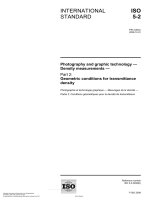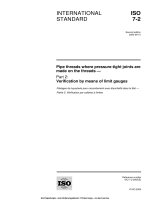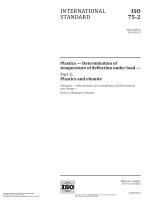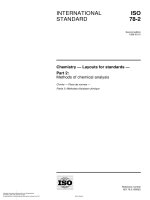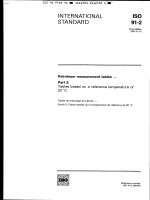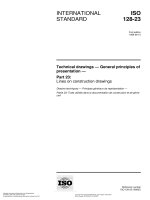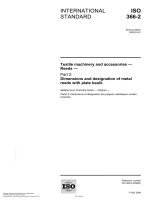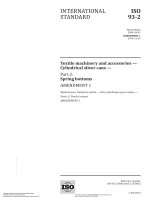Tiêu chuẩn iso 09884 2 1999
Bạn đang xem bản rút gọn của tài liệu. Xem và tải ngay bản đầy đủ của tài liệu tại đây (97.51 KB, 18 trang )
INTERNATIONAL
STANDARD
ISO
9884-2
First edition
1999-04-01
Tea sacks — Specification —
Part 2:
Performance specification for sacks for
palletized and containerized transport of tea
Sacs à thé — Spécifications —
Partie 2: Spécifications de performance des sacs utilisés pour le transport
palettisé et conteneurisé du thé
--`,,```,,,,````-`-`,,`,
Copyright International Organization for Standardization
Provided by IHS under license with ISO
No reproduction or networking permitted without license from IHS
A
Reference number
ISO 9884-2:1999(E)
Not for Resale
ISO 9884-2:1999(E)
Foreword
ISO (the International Organization for Standardization) is a worldwide federation of national standards bodies (ISO
member bodies). The work of preparing International Standards is normally carried out through ISO technical
committees. Each member body interested in a subject for which a technical committee has been established has
the right to be represented on that committee. International organizations, governmental and non-governmental, in
liaison with ISO, also take part in the work. ISO collaborates closely with the International Electrotechnical
Commission (IEC) on all matters of electrotechnical standardization.
Draft International Standards adopted by the technical committees are circulated to the member bodies for voting.
Publication as an International Standard requires approval by at least 75 % of the member bodies casting a vote.
International Standard ISO 9884-2 was prepared by Technical Committee ISO/TC 34, Agricultural food products,
Subcommittee SC 8, Tea.
ISO 9884 consists of the following parts, under the general title Tea sacks — Specification :
Part 1: Reference sack for palletized and containerized transport of tea
Part 2: Performance specification for sacks for palletized and containerized transport of tea
Annexes A and B form an integral part of this part of ISO 9884. Annex C is for information only.
--`,,```,,,,````-`-`,,`,,`,`,,`---
© ISO 1999
All rights reserved. Unless otherwise specified, no part of this publication may be reproduced or utilized in any form or by any means, electronic
or mechanical, including photocopying and microfilm, without permission in writing from the publisher.
International Organization for Standardization
Case postale 56 • CH-1211 Genève 20 • Switzerland
Internet
Printed in Switzerland
ii
Copyright International Organization for Standardization
Provided by IHS under license with ISO
No reproduction or networking permitted without license from IHS
Not for Resale
©
ISO
ISO 9884-2:1999(E)
Introduction
--`,,```,,,,````-`-`,,`,,`,`,,`---
ISO 9884-1 specifies the materials, construction and dimensions of a reference sack which has been demonstrated
by rigorous transport and storage trials to be suitable for the palletized and containerized transport of tea.
Continuing development of improved materials is resulting in the availability of sacks of different materials and
construction to serve this purpose. This part of ISO 9884 sets minimum requirements and performance tests to
ensure that such sacks are equivalent or superior in performance to the reference sack. Guidance on the filling of
tea sacks is given in annex C, for information only.
Copyright International Organization for Standardization
Provided by IHS under license with ISO
No reproduction or networking permitted without license from IHS
iii
Not for Resale
--`,,```,,,,````-`-`,,`,,`,`,,`---
Copyright International Organization for Standardization
Provided by IHS under license with ISO
No reproduction or networking permitted without license from IHS
Not for Resale
INTERNATIONAL STANDARD
ISO 9884-2:1999(E)
© ISO
Tea sacks — Specification —
Part 2:
Performance specification for sacks for palletized and containerized
transport of tea
1 Scope
This part of ISO 9884 specifies requirements and tests to determine the suitability of sacks for the palletized and
containerized transport of tea on standard pallets of standard unit load size in standard containers (see
ISO 9884-1).
2 Normative references
The following standards contain provisions which, through reference in this text, constitute provisions of this
International Standard. At the time of publication, the editions indicated were valid. All standards are subject to
revision, and parties to agreements based on this International Standard are encouraged to investigate the
possibility of applying the most recent editions of the standards listed below. Members of IEC and ISO maintain
registers of currently valid International Standards.
ISO 1573:1980, Tea — Determination of loss in mass at 103 °C.
ISO 2758:—1), Paper — Determination of bursting strength.
ISO 4120:1983, Sensory analysis — Methodology — Triangular test.
ISO 4121:1987, Sensory analysis — Methodology — Evaluation of food products by methods using scales.
ISO 6590-1:1983, Packaging — Sacks — Vocabulary and types — Part 1: Paper sacks.
ISO 7965-1:1984, Packaging — Sacks — Drop test — Part 1: Paper sacks.
--`,,```,,,,````-`-`,,`,,`,`,,`---
ISO 9884-1:1994, Tea sacks — Specification — Part 1: Reference sack for palletized and containerized transport of
tea.
1) To be published. (Revision of ISO 2758:1983)
Copyright International Organization for Standardization
Provided by IHS under license with ISO
No reproduction or networking permitted without license from IHS
1
Not for Resale
ISO 9884-2:1999(E)
©
ISO
3 Definitions
For the purposes of this part of ISO 9884, the definitions given in ISO 6590-1 apply.
4 Requirements
4.1 Sack type
Sacks shall be constructed with flat hexagonal ends and shall consist of at least two plies.
4.2 Dimensions
The filled sack dimensions shall be as given in table 1 of ISO 9884-1:1994.
4.3 Construction materials
4.3.1 General
All materials used in the construction of the sack (paper, plastics, adhesive, barrier ply) shall be free from taint
and/or odour. No materials containing chlorophenols or their derivatives shall be used.
4.3.2 Outer ply
The outer-ply material shall have a minimum wet burst index of 1,2 kN/g, when tested in accordance with ISO 2758.
4.3.3 Innermost ply
The inner ply shall be an aluminium-foil-coated barrier ply with the aluminium facing inwards, complying with
ISO 9884-1, or of a material having a permeability to chlorophenol or chloroanisole not greater than that of the inner
ply of a sack complying with ISO 9884-1, when tested by the method given in annex B.
4.4 Performance requirements
4.4.1 Drop test
When a minimum of three sacks filled with 60 kg of tea are dropped three times (once each on a face, butt and side)
from a constant height of 3 m, in accordance with the method given in ISO 7965-1, there shall be no rupture of
sacks resulting in loss of contents.
4.4.2 Transport trials
Sacks shall match or surpass the performance of reference sacks (see ISO 9884-1) throughout a minimum of
6 months of intercontinental transport trials carried out in accordance with annex A.
5 Test report
The test report may be used by a sack manufacturer to certify that a sack conforms to the requirements of this
specification. It shall specify the following details.
a)
2
Sack specification:
1)
materials;
2)
construction (number and type of plies);
3)
dimensions.
--`,,```,,,,````-`-`,,`,,`,`,,`---
Copyright International Organization for Standardization
Provided by IHS under license with ISO
No reproduction or networking permitted without license from IHS
Not for Resale
ISO
©
b)
c)
ISO 9884-2:1999(E)
Drop test results:
1)
number of sacks tested and date(s) of the test;
2)
mass and type of tea;
3)
name of organization performing the test.
Transport trials:
1)
place and date of production, grades and invoice/bulk numbers of the tea;
2)
moisture content of the tea at point of packing;
3)
number and mass of the reference sacks and the trial sacks packed for each bulk/invoice;
4)
place and date of packing/palletization;
5)
date and means/route of transport to port of loading;
6)
port and date of departure;
7)
vessel and details of
stowage of the test and reference pallets,
other cargo carried;
8)
route of the voyage and the date of arrival in the terminal port;
9)
means of transport to, and place and date of opening the containers;
10) condition on receipt (see A.2.4);
11) numbers of sample sacks and mass of samples taken;
12) moisture contents of the samples and the name of the organization carrying out the analysis;
13) names and affiliations of the tea tasters carrying out the organoleptic assessments, the dates of the
assessments and the results.
--`,,```,,,,````-`-`,,`,,`,`,,`---
Copyright International Organization for Standardization
Provided by IHS under license with ISO
No reproduction or networking permitted without license from IHS
3
Not for Resale
ISO 9884-2:1999(E)
©
ISO
Annex A
(normative)
Transport trials
A.1 General procedure
Trial sacks shall be compared with reference sacks (see ISO 9884-1) filled with the same bulk or invoice of tea at
the same time under identical conditions, transported together and opened at the same time under identical
conditions.
At least 1 000 filled test sacks shall be shipped in a minimum of four vessels over a minimum period of 6 months in
a minimum of two containers per vessel. Each test container shall hold at least 100 trial sacks and 100 reference
sacks.
incidence and extent of sack damage;
incidence and extent of product spillage/loss;
moisture content of tea on arrival;
organoleptic quality of tea on arrival.
--`,,```,,,,````-`-`,,`,,`,`,,`---
The test and reference sacks shall be compared on the basis of:
A.2 Specific procedures
A.2.1 Tea from the same bulk or invoice shall be used to fill equal numbers of trial and reference sacks.
NOTE
Several bulks may be used to make up paired pallet loads of trial and reference sacks to fill the test containers.
A.2.2 A minimum of three samples of each bulk of tea shall be taken during the sack-filling operation. The moisture
content of each sample shall be determined in accordance with the method given in ISO 1573.
A.2.3 Paired pallets of trial sacks and reference sacks shall be placed adjacently in the test container, alternating
in position to achieve an even distribution from side to side and top to bottom.
EXAMPLE
TRTTR
RTRRT
where T is a trial sack and R is a reference sack.
A.2.4 On arrrival at the destination, the condition of the contents of each test container shall be examined as they
are removed and stored in the warehouse. An inspection record shall be completed (with photographs illustrating
damage) setting out:
dates of arrival and unpacking;
the condition, appearance and stability of each pallet load (test and reference sacks);
4
Copyright International Organization for Standardization
Provided by IHS under license with ISO
No reproduction or networking permitted without license from IHS
Not for Resale
©
ISO
ISO 9884-2:1999(E)
the damage incurred by both test and reference sacks;
the extent of any product spillage/loss.
A.2.5 Samples shall be taken on arrival from undamaged trial sacks and reference sacks at the top, middle and
bottom of each pallet, and these samples shall be bulked. The moisture contents of the bulked samples shall be
determined in accordance with the method given in ISO 1573. The moisture contents of samples from trial pallets
shall not exceed those of samples from the paired reference pallets.
A.2.6 At least two consignments of tea, having successfully completed a transport trial from producing factory to
purchaser's warehouse, shall be subjected to a comparative taste assessment. This shall be carried out by a
minimum of four professional tea tasters (at least two of whom shall be independent of the producer and the
purchaser) on bulked samples from reference and test pallets containing the same original bulk tea.
The first step in this assessment shall be a difference test carried out according to the method given in ISO 4120. If
no significant difference (P less than 0,05) is found, the trial sack shall be deemed to have passed the test. If a
significant difference is found, a preference test shall be carried out in accordance with the method given in
ISO 4121 to determine which sample(s) is (are) of the higher quality. The trial sack shall be deemed to have passed
the test if the contents of the reference sacks are not significantly preferred over the contents of the trial sacks
(P less than 0,05).
--`,,```,,,,````-`-`,,`,,`,`,,`---
Copyright International Organization for Standardization
Provided by IHS under license with ISO
No reproduction or networking permitted without license from IHS
5
Not for Resale
ISO 9884-2:1999(E)
©
ISO
Annex B
(normative)
Measurement of permeability of tea sack barrier ply material —
Determination of chlorophenols and chloroanisoles by gas chromatography
B.1 General
Multi-wall paper sacks used for the bulk transport of tea include an inner aluminium-coated barrier ply to protect the
contents from contamination arising from the permeation of organic vapours such as chlorophenols and
chloroanisoles.
The method described in this annex is applicable to tea sack barrier ply materials (e.g. multilayer laminates) to
establish rates of chlorophenol and chloroanisole permeation through a material under test. This procedure may
also be considered applicable to determine rates of permeation of other organic vapours through similar barrier
materials.
B.2 Principle
A gas-tight cell is divided into two chambers by the test ply material. On one side (i.e. the outer surface of the test
material) is generated a saturated vapour of chlorophenol/chloroanisole. The other side (i.e. inner surface of the test
material) is purged with an inert gas (e.g. oxygen-free nitrogen) at a known constant rate. Organic vapours
permeating across the barrier are collected at the purged outlet of the cell onto an absorbent trap. After the elapsed
sampling period the trap is removed from the cell for chromatographic analysis of the collected sample.
--`,,```,,,,````-`-`,,`,,`,`,,`---
B.3 Reagents and materials
Use only reagents of recognized analytical grade.
B.3.1 Standard stock solutions
B.3.1.1 2,6-Dichlorophenol
Dissolve 100 mg of of 2,6-dichlorophenol in methanol and dilute to volume with methanol in a 100 ml volumetric
flask.
B.3.1.2 2,4,6-Trichlorophenol
Dissolve 100 mg of of 2,4,6-trichlorophenol in methanol and dilute to volume with methanol in a 100 ml volumetric
flask.
B.3.1.3 Pentachloroanisole
Dissolve 100 mg of pentachloroanisole in methanol and dilute to volume with methanol in a 100 ml volumetric flask.
6
Copyright International Organization for Standardization
Provided by IHS under license with ISO
No reproduction or networking permitted without license from IHS
Not for Resale
©
ISO
ISO 9884-2:1999(E)
B.3.2 Standard working solutions
Prepare concentrations of 100 ng/µl, 10 ng/µl, and 1 ng/µl, by serial dilution from the standard stock solutions
(B.3.1).
B.3.3 Tenax TA beads 2), mesh size 20 µm to 35 µm.
Tenax is a porous polymer based on 2,6-diphenyl-p-phenylene oxide.
B.4 Apparatus
Usual laboratory equipment and, in particular, the following.
B.4.1 Barrier material permeability test cell, see figure B.1.
The cell is constructed from two borosilica glass domes with flat flange and sockets (ground glass, size DA4/100,
socket size 29/32), with an external diameter of 150 mm. A disc of the test material is cut to size, and placed
between the two flanges, which are secured to form a gas-tight seal. The volume in which the saturated organic
vapour will be generated is sealed with a 29/32 ground glass stopper. A Drechsel adaptor consisting of an inlet tube
for the purging gas and an outlet to which the absorption tube will be attached is placed in the other socket of the
test cell.
B.4.2 Absorbent trap, consisting of a tube packed with the appropriate quantity of Tenax TA beads (B.3.3).
EXAMPLE
A borosilicate glass tube 160 mm long, having an external diameter of 6 mm and an internal diameter of 3 mm, plugged
towards one end with glass wool. Then 100 mg of Tenax TA beads (B.3.3) are packed into the tube, which is closed with a
glass wool plug.
B.4.3 Thermodesorption cold trap injector, for the transfer of the sample from the absorbent trap (B.4.2) to the
gas chromatograph (B.4.4) (see figure B.2).
B.4.4 Gas chromatograph, with electron-capture detector and integrator, and a non-polar type capillary column.
The column is typically 12 m long with 0,2 mm internal diameter, coated with a film of 0,33 µm thickness of
100 % (m/m) dimethylpolysiloxane.
B.5 Procedure
B.5.1 Preparation of glassware
Clean all glassware by heating to 200 °C for at least 30 min, then allow to cool to ambient temperature before use.
B.5.2 Preparation of test sample
B.5.2.1 Cut a 150 mm diameter circular disc of the test material.
B.5.2.2 Position the disc between the two flanged domes of the test cell (B.4.1) with the outer surface facing the
volume to be saturated with the organic vapour. Secure the two flanges and ensure that they are gas tight.
2) Tenax TA is an example of a suitable product available commercially. This information is given for the convenience of users
of this part of ISO 9884 and does not constitute an endorsement by ISO of this product.
--`,,```,,,,````-`-`,,`,,`,`,,`---
Copyright International Organization for Standardization
Provided by IHS under license with ISO
No reproduction or networking permitted without license from IHS
7
Not for Resale
ISO 9884-2:1999(E)
©
ISO
B.5.3 Preparation of absorbent trap
B.5.3.1 Pass oxygen-free nitrogen through the trap at a flow rate of 20 ml/min. Heat the trap to 250 °C for 15 min,
and allow it to cool to ambient temperature.
B.5.3.2 Using a microlitre syringe, inject 1 ml of the standard working solution (B.3.2) onto the glass wool plug
which will be adjacent to the test cell outlet when the trap is in place (B.5.5.2).
B.5.4 Assembly of permeability test cell
B.5.4.1 Insert the Drechsel adaptor so that the end of the inlet tube carrying the purging gas is about 1 cm above
the surface of the test material.
B.5.4.2 Place a small beaker containing the permeability test compound (e.g. a chlorophenol) on the stopper used
to close the saturated volume chamber (A) and secure the stopper in place.
B.5.5 Collection of the sample
B.5.5.1 Attach a supply of oxygen-free nitrogen to the inlet tube and set the gas flowrate at 60 ml/min. Allow time
for the permeated vapour to reach a steady state in the purged volume chamber (B).
NOTE
As an example, for an aluminium/polyethylene/kraft paper laminate, the time taken to reach steady state is 3 days to
7 days for chlorophenols, and 7 days to 14 days for chloroanisoles.
B.5.5.2 Connect the absorbent trap (B.5.3) to the outlet and leave in place for a measured time interval of at least
4 h.
B.5.6 Transfer of sample
B.5.6.2 Connect an oxygen-free nitrogen supply at a flow rate of 4 ml/min to the absorbent trap. Raise the
temperature of the desorption oven to 250 °C, with the cold trap at -100 °C.
B.5.7 Analysis by capillary gas chromatography
B.5.7.1 Setting up the apparatus
B.5.7.1.1 Injector
Close the cooling supply to the thermodesorption cold trap injector, and heat the cold trap up to a temperature of
260 °C. The sample passes in the gas stream into the gas chromatograph column at an injector temperature of
250 °C.
The heating rate for the cold trap is typically 10 °C to 15 °C per second.
B.5.7.1.2 Oven and column
The oven temperature cycle on the gas chromatograph is started at the same time as the cold trap heating on the
injector.
It is essential that a temperature programme be used to achieve a baseline separation between the peaks which are
to be measured.
A typical temperature programme is 120 °C for 1 minute, followed by an increase at 10 °C per minute to 250 °C,
with a carrier gas flow through the thermodesorption equipment of 4 ml/min.
8
Copyright International Organization for Standardization
Provided by IHS under license with ISO
No reproduction or networking permitted without license from IHS
Not for Resale
--`,,```,,,,````-`-`,,`,,`,`,,`---
B.5.6.1 Remove the absorbent trap and connect it to the thermodesorption cold trap injector (B.4.3), cooled with
liquid nitrogen.
©
ISO
ISO 9884-2:1999(E)
B.5.7.2 Determination
The retention times on the capillary column for each of the test compounds and internal standards are determined
by injecting standard solutions onto the Tenax absorbent trap, and transferring them by the method described to the
gas chromatograph.
B.5.7.3 Examination of chromatograms
When the gas chromatograph is operated under the conditions given in B.5.7.1.2, the retention times should
typically be as follows:
Minutes
Peak
0,96
air
2,71
2,6-dichlorophenol
4,41
2,4,6-trichlorophenol
8,56
pentachloroanisole
B.6 Expression of results
B.6.1 The method allows the quantitative determination of the amount of organic vapour passing through the
barrier ply material over the sampling time.
The response of the detector is a function of the chlorine content of each compound. The 1 ng samples of the
compounds used give peak areas with the following relative values:
2,6-dichlorophenol
26
2,4,6-trichlorophenol
192
pentachloroanisole
388
B.6.2 The transmission rate of the barrier ply material is calculated as follows:
B.6.2.1 The mass of the test compound transmitted, mt, expressed in grams, is given by
--`,,```,,,,````-`-`,,`,,`,`,,`---
mt =
At Rs
×
As Rt
where
At
is the peak area of the test sample;
As
is the peak area of the standard;
Rs
is the relative response of the standard;
Rt
is the relative response of the test sample.
Copyright International Organization for Standardization
Provided by IHS under license with ISO
No reproduction or networking permitted without license from IHS
9
Not for Resale
ISO 9884-2:1999(E)
©
ISO
B.6.2.2 The transmission rate, TR, expressed in grams per square metre per 24 h, is given by
TR =
mt
t
× Ae
24
where
t
is the time, in hours, over which the sample was collected;
Ae
is the exposed area, in square metres, of the test sample.
B.7 Test report
The test report shall specify:
all information necessary for the complete identification of the sample;
the sampling method used, if known,
the test method used, with reference to this part of ISO 9884;
all operating details not specified in this annex, or regarded as optional, together with details of any incidents
which may have influenced the test result(s);
the test result(s) obtained, expressed in accordance with B.6.2.
--`,,```,,,,````-`-`,,`,,`,`,,`---
Key
1 Purge gas inlet
5 Tenax TA absorption tube
2 Drechsel adaptor
6 Permeability test compound
3 Tea sack barrier ply material
7 Purged volume chamber (B)
4 Purge gas outlet
8 Saturated volume chamber (A)
Figure B.1 — Diagram of the permeability test cell
10
Copyright International Organization for Standardization
Provided by IHS under license with ISO
No reproduction or networking permitted without license from IHS
Not for Resale
©
ISO
ISO 9884-2:1999(E)
Key
1 Carrier gas
5 Transfer tube
2 Thermal desorption oven
6 Electrically heated metal capillary
3 Trap cooling system
7 Gas chromatograph injection port
4 Tenax TA absorption tube
8 GC capillary column
Figure B.2 — Schematic diagram of the thermodesorption cold trap injector
--`,,```,,,,````-`-`,,`,,`,`,,`---
Copyright International Organization for Standardization
Provided by IHS under license with ISO
No reproduction or networking permitted without license from IHS
11
Not for Resale
ISO 9884-2:1999(E)
©
ISO
Annex C
(informative)
Guidance on the filling of tea sacks
C.1 Objectives
It is important when filling tea sacks to ensure that the sacks are packed at their optimum weights, taking account of
the different bulk densities of tea grades. Correct filling should
ensure that sacks stacked on pallets or slip-sheets can be easily loaded into and unloaded from containers
without damage or loss of tea;
achieve safe and stable pallet or slip-sheet loads.
C.2 Optimum packing weight
Because the bulk density of the tea will vary from grade to grade, optimum packing weights should be determined
before packing a consignment of tea.
NOTE
Overfilled sacks lead to bulging, instability and possible damage to the sack with loss of tea, particularly when they
are being loaded into a container from pallets. Underfilled sacks may lead to excessive movement and separation of leaf which
may result in unstable sacks, and overall packaging and freight costs will be higher.
C.3 Method of filling
There are a variety of different methods for filling sacks; these range from manual methods to fully automated
operations. For each method, the optimum weight that can be filled should be set on the scale, taking into account
the tare weight of the sack.
C.4 Vibration
The sealed sack should be placed horizontally in a former attached to a vibrator.
Whilst vibration is necessary, this process can contribute to leaf damage and separation, and just suffficient
vibration should be used to obtain the required sack shape.
It is inappropriate to propose a vibration time as a range of variables exist. If, however, sacks require more than
1 min on the vibrator, the tea weights selected should be re-checked (see C.2 and C.3).
--`,,```,,,,````-`-`,,`,,`,`,,`---
12
Copyright International Organization for Standardization
Provided by IHS under license with ISO
No reproduction or networking permitted without license from IHS
Not for Resale
--`,,```,,,,````-`-`,,`,,`,`,,`---
Copyright International Organization for Standardization
Provided by IHS under license with ISO
No reproduction or networking permitted without license from IHS
Not for Resale
ISO 9884-2:1999(E)
©
--`,,```,,,,````-`-`,,`,,`,`,,`---
ICS 55.080; 67.140.10
Price based on 12 pages
Copyright International Organization for Standardization
Provided by IHS under license with ISO
No reproduction or networking permitted without license from IHS
Not for Resale
ISO

